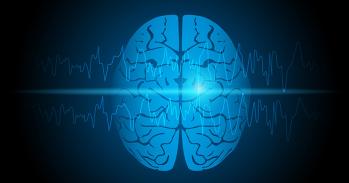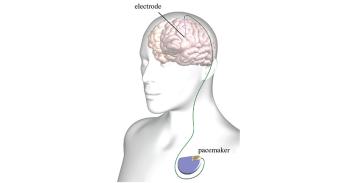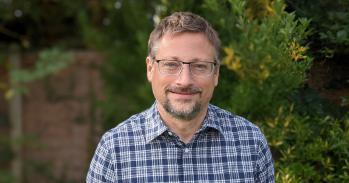
A bedside device that measures ‘brain signatures’ could help diagnose patients who have consciousness disorders – such as a vegetative state – to work out the best course of treatment and to support family counselling.
A bedside device that measures ‘brain signatures’ could help diagnose patients who have consciousness disorders – such as a vegetative state – to work out the best course of treatment and to support family counselling.
The patient might be awake, but to what extent are they aware? Can they hear, see, feel? And if they are aware, does their level of awareness equate to their long-term prognosis?
Srivas Chennu
In 10 minutes, Srivas Chennu can work out what’s going on inside your head.
With the help of an electrode-studded hairnet wired up to a box that measures patterns of electrical activity, he can monitor the firing of millions of neurons deep within the brain. A few minutes later, wheeling his trolley-held device away, he has enough information to tell how conscious you really are.
What Chennu is looking for with his electroencephalogram (EEG) is the brain’s electrical ‘signature’. At any one moment in the body’s most complex organ, networks of neurons are firing up and creating ‘brain waves’ of electrical activity that can be detected through the scalp net.
This isn’t new technology – the first animal EEG was published a century ago – but computational neuroscientist Chennu has come up with a way of combining its output with a branch of maths called graph theory to measure the level of a person’s consciousness. What’s more, he’s developing the technology as a bedside device for doctors to diagnose patients suffering from consciousness disorders (such as a vegetative state caused by injury or stroke) to work out the best course of action and to support family counselling.
“Being conscious not only means being awake, but also being able to notice and experience,” he explains. “When someone is conscious, there are patterns of synchronised neural activity arcing across the brain that can be detected using EEG and quantified with our software.”
So for a healthy brain, the brain’s signature might look like a raging scrawl of lines sweeping back and forth, as integrated groups of neurons perceive, process, understand and sort information. When we sleep, this diminishes to a squiggle of the faintest strokes as we lose consciousness, flaring occasionally if we dream.
“Understanding how consciousness arises from neural interactions is an elusive and fascinating question. But for patients diagnosed as vegetative and minimally conscious, and their families, this is far more than just an academic question – it takes on a very real significance.
“The patient might be awake, but to what extent are they aware? Can they hear, see, feel? And if they are aware, does their level of awareness equate to their long-term prognosis?”
Chennu points to charts showing the brain signature of two vegetative patients. On one chart, just a few lines appear above the skull. In the other, the lines are so many they resemble, as Chennu describes, a multi-coloured mohican, almost indistinguishable from the signature one would see from a healthy person.
Did either of the patients wake up? “Yes, the second patient did, a year after this trace was taken. The point is, if you think that a patient will wake up, what would you do differently as a clinician, or as a family member?”
The research is based on the finding that a patient in a vegetative state could respond to yes or no questions, as measured by distinct patterns of brain activity using functional magnetic resonance imaging. It was discovered by Chennu’s colleagues in the Department of Clinical Neurosciences and the Medical Research Council Cognition and Brain Sciences Unit (MRC CBSU), led by Dr Adrian Owen.
In 2011, the group found the same attention to commands could be measured using EEG – a less expensive and more widely available technology. Three years later, Chennu and Dr Tristan Bekinschtein from the CBSU, and now in the Department of Psychology, showed that their mathematical analysis of the EEG outputs was enough to measure the ambient amount of connectivity in a patient’s brain.
Chennu hopes that the machine will fill a technology gap: “Misdiagnosis of true levels of consciousness in vegetative patients continues to be around 40% and depends on behavioural examination. In part this is because there is no gold standard for the assessment of a patient’s awareness at the bedside.”
With funding from the Evelyn Trust, he will assess and follow the treatment and rehabilitation trajectory of 50 patients over a three-year period. This will be the first time that a study has linked diagnosis, treatment and outcome to regular real-time assessment of the activity of a patient’s brain.
Meanwhile he is continuing to develop the medical device with industry as part of the National Institute for Health Research Healthcare Technology Co-operative for Brain Injury, which is hosted within the Department of Clinical Neurosciences.
“Medical advances mean that we are identifying subtypes of brain injury and moving away from ‘one size fits all’ to more-targeted treatment specific for an individual’s needs,” adds Chennu, who is also funded by the James S. McDonnell Foundation and works as part of a team led by Professors John Pickard and David Menon.
Intriguingly the device could even offer a channel of communication, as Chennu speculates: “The question that fascinates us is what type of consciousness do patients have? Perhaps we can create systems to translate neural activity into commands for simple communication – interfaces that could provide a basic but reliable communication channel from the ‘inbetween place’ in which some patients exist.
“Moreover, we think that the measurement of brain networks will provide clinically useful information that could help with therapeutics for a larger majority of patients, irrespective of whether they are able to demonstrate hidden consciousness.”
How conscious is my dog? Can robots become conscious? Are people in a vegetative state conscious? Don't miss Philosopher Professor Tim Crane and neuroscientist Dr Srivas Chennu at the Cambridge Science Festival, where they will look into our minds and wrestle with the meaning of what it is to be conscious. 'Brain, body and mind: new directions in the neuroscience and philosophy of consciousness', the Research Horizons Public Lecture, will be on Wednesday 16 March 2016, 8pm–9pm, Mill Lane Lecture Rooms, Mill Lane, Cambridge. Pre-booking required.
New directions in the study of the mind
We know a great deal about the brain but what does it actually mean to be conscious, asks a new research programme in the Faculty of Philosophy.
In what way are newborn babies, or animals, conscious? Why do some experiences become part of one’s consciousness yet others do not?
“It’s sometimes assumed that it’s obvious what consciousness is, and the only question is how it is embodied in the brain,” says Professor Tim Crane. “But many people now recognise that it’s not clear what it means to say that something has a mind, or is capable of thought or conscious experience. My view is that there are lots of assumptions that are being made in order to get to that conclusion and not all of the assumptions are correct.”
Crane leads a new research initiative in the Faculty of Philosophy supported by the John Templeton Foundation that aims to tackle the broad question of the essence of the mind. And to do this they are moving beyond the reductionist view that everything can be explained in terms of the nuts and bolts of neuroscience.
“That doesn’t mean we are interested in proving the existence of the immortal soul, or defending any religious doctrine – we are interested in the idea that the brain’s-eye view isn’t everything when it comes to understanding the mind.
“The nervous system clearly provides the mechanism for thought and consciousness but learning about it doesn’t tell us everything we need to know about phenomena like the emotion of parental love, or ambition or desire. The mere fact that something goes on in your brain when you think does not explain what thinking essentially is.”
The team in Cambridge are also distributing funds for smaller projects elsewhere in the world, each of which is tackling similar questions of consciousness in philosophy, neuroscience and psychology.
“Collectively we want to recognise ‘the reality of the psychological’ without saying that it’s really just brain chemicals,” adds Crane. “It’s important to face up to the fact that we are not just our neurons.”

The text in this work is licensed under a Creative Commons Attribution 4.0 International License. For image use please see separate credits above.




